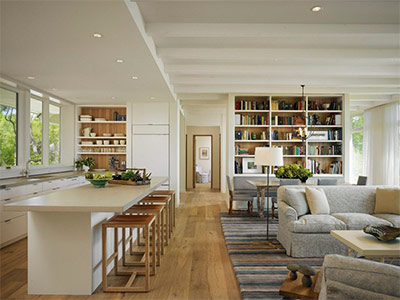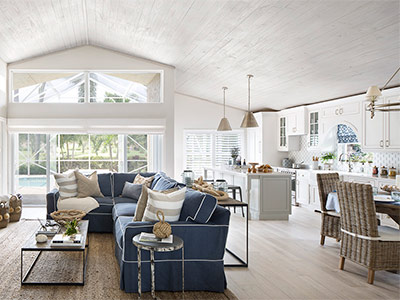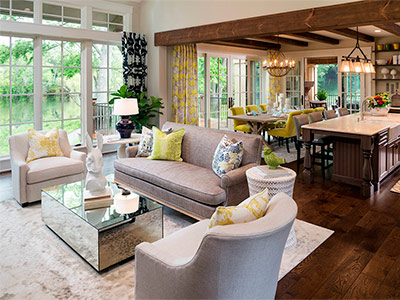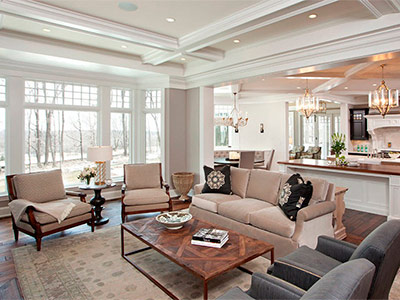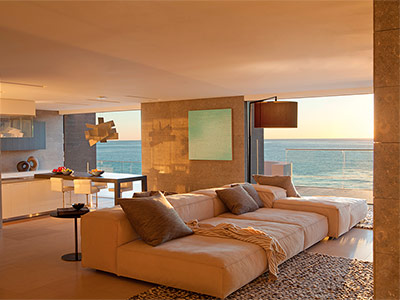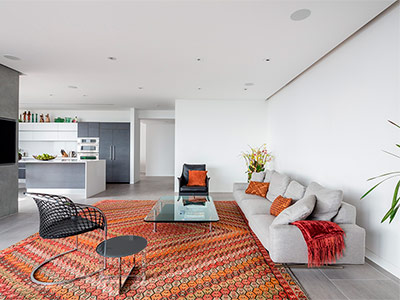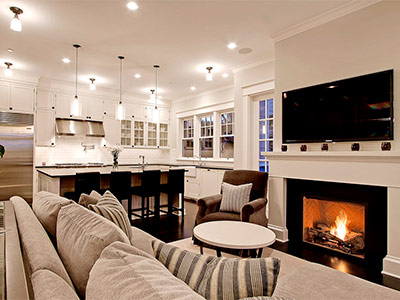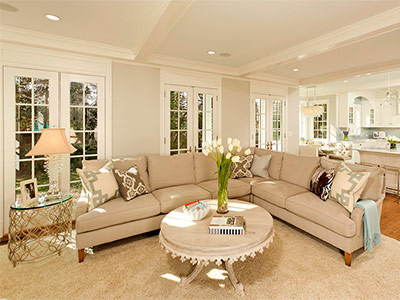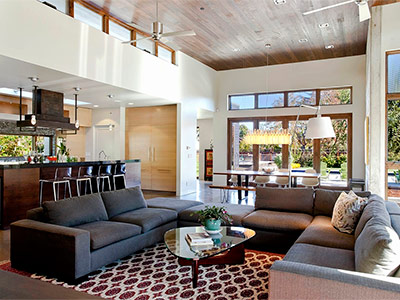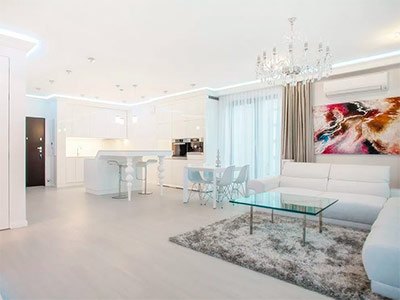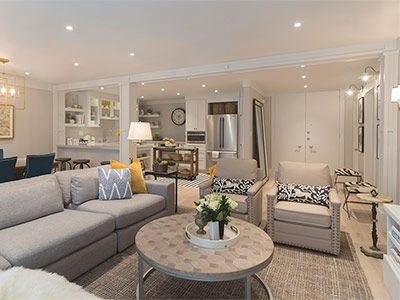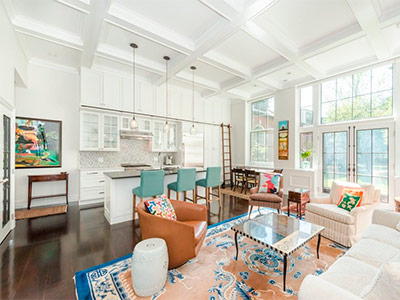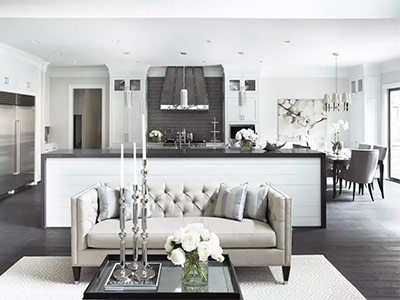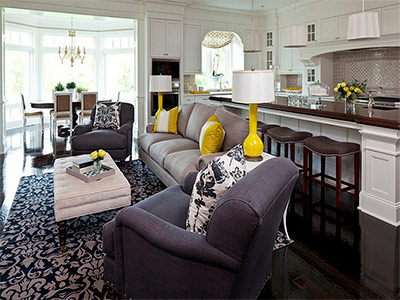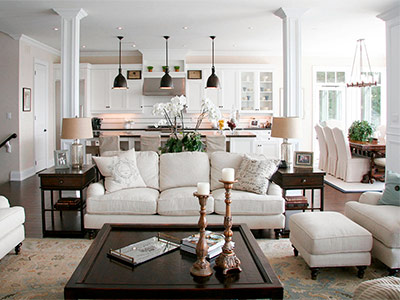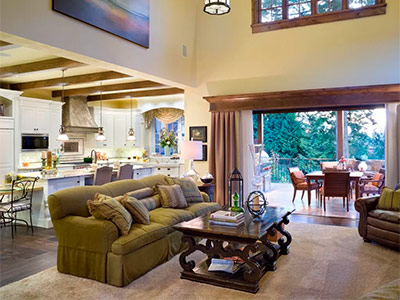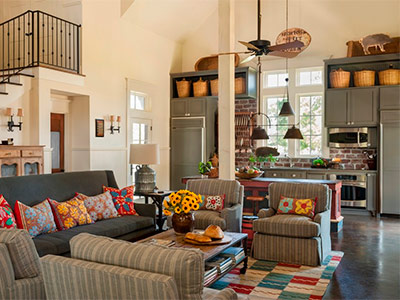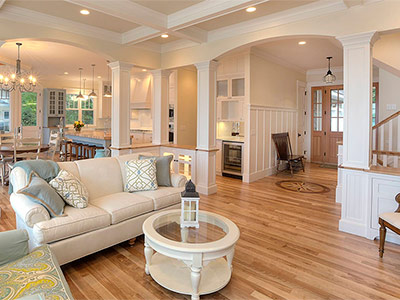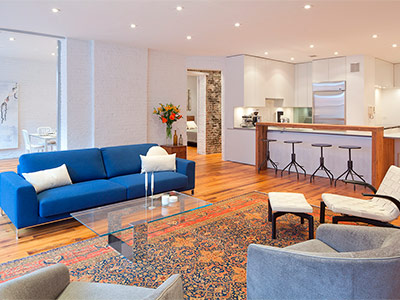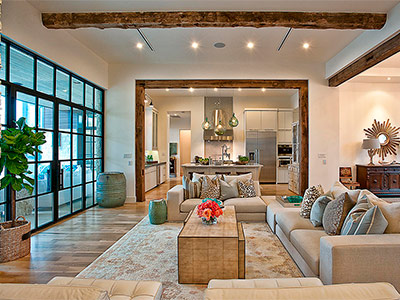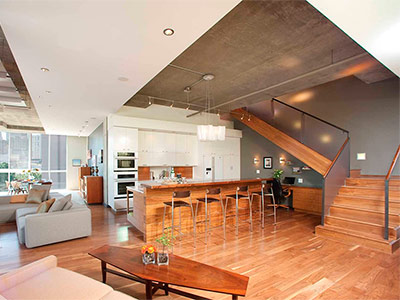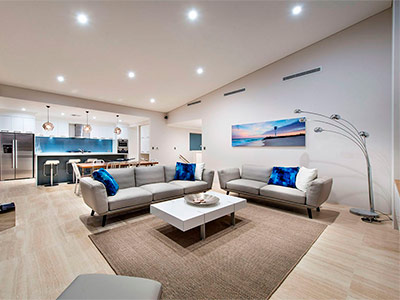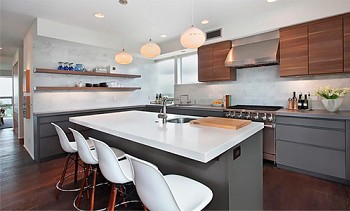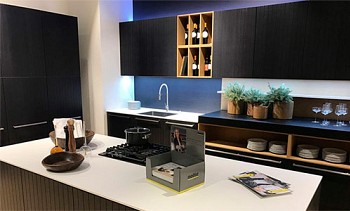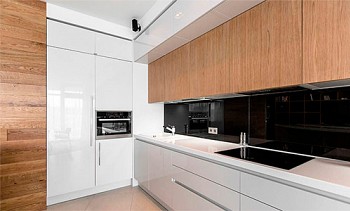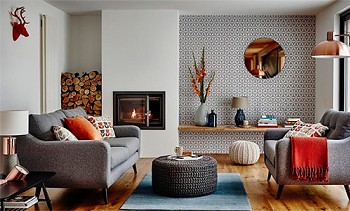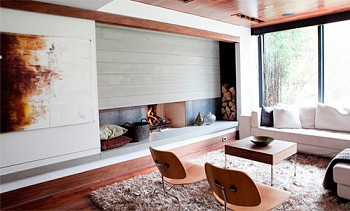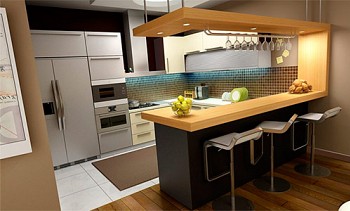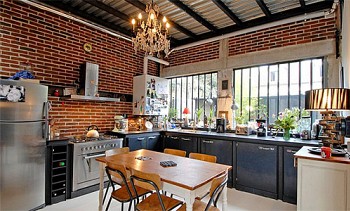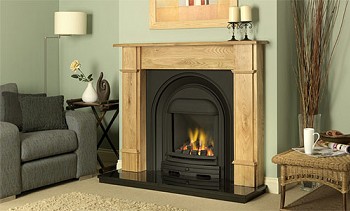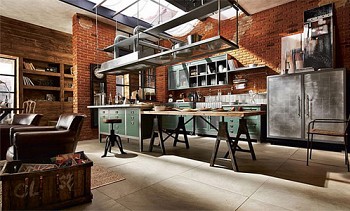Interior design of a living room combined with a kitchen
Of course, you will have to work hard to achieve the required level of functionality of the kitchen, isolated from other rooms, but this certainly cannot be called a problem. It is much more difficult to do this when we are dealing with combined rooms and an open plan. How to make the interior of the kitchen, combined with the living room, functional and at the same time beautiful? Obviously, the combination of the kitchen and the living room should be so perfect that they cannot be distinguished. One big question remains: how?
Search for your answer! And to make it easier for you along the way, get acquainted with ready-made ideas living room design combined with the kitchen.
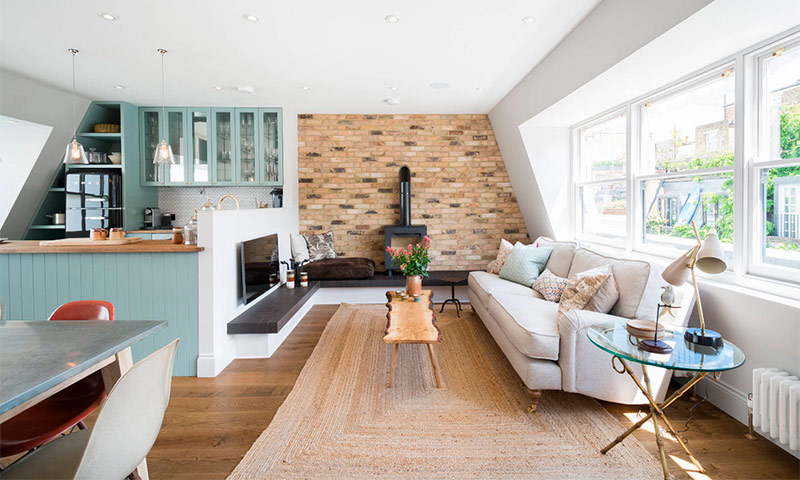
Content:
- Color and texture. Focus on consistency
- Do not create artificial corridors
- Avoid the temptation to make a partition
- Let accessories do their job
- Don't forget the details
- Refuse open shelving
- Small kitchen table
- Do not forget about the functionality of furniture
- Keep odors and noises in check
- Make sure you have enough storage space.
- Do not change the selected style.
- Photo: living room combined with kitchen
Color and texture. Focus on consistency
The kitchen – living room combination should be monochrome. There should be no difference in colors and shades, and a clear border on the wall and floor should not be visible. After all, why do you need to separate the spaces if you have previously decided to combine them? Doesn't this spacious room seem impressive to you?
Materials, like colors, must match. If the walls in one part of the room are tiled, then the tile should be in another part. If the furniture in the living room is covered with woolen wraps, then the same bedspreads should be present in the kitchen area. So simple!
Using this guiding rule when buying materials, do not forget about functionality. The materials you choose should function equally well in both parts of the room. For example, ceramic tiles are ideal for the floor in the kitchen, but such a floor covering will make your living room less nice and cozy.
In general, it is very difficult to choose a floor covering suitable for both the kitchen and the living room. The best option, probably, can be a high-quality natural stone, but such a choice will require considerable financial investments from you. If you still decide to use different materials to cover the floor in the living room and kitchen areas, make sure that they are similar in tone and texture. Wrong (in this case, contrasting) choice will simply destroy all harmony and balance.
Do not create artificial corridors
Is it difficult to resist the temptation to make a “visual corridor” leading to the kitchen? But you still have to fight this desire! Architects did everything to make it easier to get into the kitchen, so why would you destroy their (and your) ideas? The more complicated and confusing the path to the kitchen looks, the less will you and your household wish to overcome this path!
Do not clutter the road with couches and tables. The exact opposite is required of you: move the furniture to the side and thereby maximize free space. Thanks to this, you will be able to move freely in the direction you need, and no one will have the feeling that there are two rooms instead of one.
Avoid the temptation to make a partition
An open kitchen should look exactly the way it sounds - open. People often deceive themselves with the idea of providing a certain level of privacy and, for its implementation, delimit the space with all kinds of artificially created partitions - folding screens, curtains, bookshelves or even whole panels.
Ladies and gentlemen, why did you initially abandon the wall between the living room and the kitchen?
The reason we need an open plan is our desire to have a bright and airy room. Both physical and intuitive barriers are likely to simply destroy your dream of space.
Say decisively “no” to any hints of partitions. Instead, try to achieve harmony in the interior by choosing the right furniture. And the rules here are quite simple: you should avoid high elements of the interior and give preference to spacious cabinets that are equally deployed throughout the room. Using two completely different sets of furniture will make the kitchen and living room seem smaller than they really are. All attention in this case will be riveted to only one of the headsets, as a result of which the feeling of integrity of the space to which you aspired will disappear. Remember: the main way to achieve the ultimate goal is to seek balance.
Let accessories do their job
Still want to give each zone your personality? Your main assistants in this matter will be accessories! The same objects, but located in different ways, can be an indication that there is still some kind of separation in a seemingly integral space. For example, sofas in the living room can stand on one side, and in the kitchen - on the opposite. Works of art and rugs can also serve as zone dividers.
Don't forget the details
What does a decorative pillow lying on a sofa in the living room mean? Strictly speaking, nothing is just a pillow. For a combined room, the same pillow can become a whole world. When you mix interiors, each seemingly insignificant detail will act as a “mixer”! Many do not think about this, but from a financial point of view it is much more profitable to decorate one generalized interior than two separate rooms.
Refuse open shelving
Although, as you rightly believe, wall cabinets are not exactly what you need for open-plan living spaces, the alternative - open shelving - seems even more risky. Open shelves are a great solution for the kitchen (they look nice and attractive there), but in the living room they do not seem quite appropriate.
First of all, the presence of open racks threatens a constant mess in your kitchen-living room (this is not about dirt and dust, but about the mess, about the chaos of things located on these shelves). Therefore, if you still choose this path, you will need to carefully think through all the details in advance.
Another aspect that should be taken into account is the color and degree of dullness of the surfaces. As mentioned above, in the design of the living room, combined with the kitchen, there should be no obvious contrasts in the colors and textures. This means that all shelves in the room must be of the same tone. Are you sure that you want it, that you will like the end result?
Summing up all of the above, we strongly advise you not to commit “mortal sin” in the form of using open shelves to separate areas. Why do you need an artificially created mess? To delimit the space that you originally imagined was holistic and spacious?
Small kitchen table
Nowadays, people rarely use dining tables, preferring to "eat in front of the TV." If you are planning to create an open-plan kitchen-living room in your house, you certainly also belong to those families who do not feel the need for a full dining table.
Imagine a picture for a second: in the immediate vicinity of each other are a kitchen table, a dining table and a small coffee table for the living room.Isn't that too much? Isn't this a blatant bust? So why not give preference to a small table that takes up almost no space? At such a table you can comfortably have a bite to eat, combining dinner with watching your favorite television series or with a casual discussion of the events of the past day. On such a table you can set dessert when guests come to you. And, mind you, it will be much easier to clean and polish a small table; cleaning it will not require incredible efforts from you.
Do not forget about the functionality of furniture
Open plan rooms have a wonderful social aspect. They gather a family for all kinds of reasons and without reason. They help you enjoy cooking while chatting with friends. Believe us, you are sure to love this laid-back atmosphere!
We recommend that, taking into account the above, choose the most functional furniture. It must be, firstly, ideally comfortable, and secondly, resistant to pollution.
Keep odors and noises in check
To be completely honest, we must admit that the open plan has its own big drawback: smells and sounds easily spread throughout the space. That is why it will take a lot of effort to prevent the smell of cooked food from entering the living room or “traveling” to the kitchen with the sound of a working TV.
Let's start with the fight against aromas. If possible, place the stove and / or oven close to the large window and, ideally, in the farthest corner from the living area. In case of special need, install folding doors that you will close only during cooking.
As for the noise, then everything is a little more complicated. Unfortunately, there is no way to prevent the sound from spreading around the room. The only thing you can do is to introduce elements into the interior that are capable of “absorbing” it (heavy draperies, soft furniture upholstery, all kinds of wraps, pillows, etc.). Folding doors can also help a bit in this case.
Make sure you have enough storage space.
Choosing an open plan of living space, you should be prepared for the fact that the issue of storage space will become more acute for you. Instead of placing many cabinets in the room, think of multi-purpose items that, in addition to their main function, can serve as storage.
For example, you can set an island kitchen table (this will be your work surface, which at the same time allows you to hide pans and plates from your eyes) or a bar counter with a closed base (it will serve not only as a breakfast table, but also as a place for storing cookbooks, small supplies products or bags).
Do not change the selected style.
This statement can be considered a conclusion to everything that was said earlier. When working on the design of the kitchen combined with the living room, you should especially carefully monitor the preservation of the stylistic consistency and consistency of the individual parts of the created whole. All elements of the interior should harmoniously interact with each other, not one of them should “get out” of the overall picture. It's that simple!













